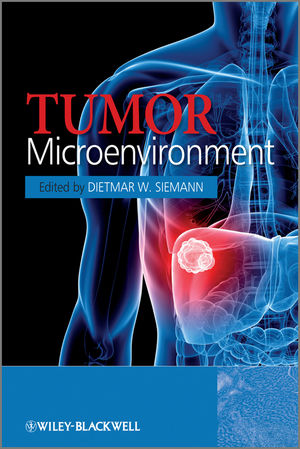Tumor MicroenvironmentISBN: 978-0-470-74996-8
Hardcover
454 pages
November 2010
 This is a Print-on-Demand title. It will be printed specifically to fill your order. Please allow an additional 15-20 days delivery time. The book is not returnable.
|
||||||
List of Contributors.
1 The Microenvironment in Cancer (Nicole N. Parker and Dietmar W. Siemann).
1.1 Introduction.
1.2 A highly selective process is required to obtain the cancer phenotype.
1.3 The cancer phenotype.
1.4 The extracellular matrix.
1.5 Motility, invasion, and metastatic ability.
1.6 Impact of the tumor microenvironment on the control of cancer.
1.7 Targeting the tumor microenvironment.
1.8 Summary.
2 Establishing the Tumor Microenvironment (Allison S. Betof and Mark W. Dewhirst).
2.1 Introduction.
2.2 From cancerous cells to a tumor.
2.3 A tumor is more than cancer cells and fibroblasts.
2.4 Communication between the tumor cells and stroma.
2.5 Hypoxia and angiogenesis.
2.6 Conclusion.
3 Contributions of the Extracellular Matrix to Tumorigenesis (Marie Schluterman Burdine and Rolf A. Brekken).
3.2 Manipulation of the ECM during tumor development.
3.3 Matricellular proteins and their complex effects on tumor development.
3.4 Conclusion.
4 Matrix Metalloproteinases and Their Inhibitors – Friend or Foe (Mumtaz V. Rojiani, Marzenna Wiranowska and Amyn M. Rojiani).
4.1 Introduction.
4.2 Matrix metalloproteinases.
4.3 Tissue inhibitors of matrix metalloproteinases.
4.4 Concluding comments.
5 Role of Tumor-Associated Macrophages (TAM) in Cancer Related Inflammation (Antonio Sica and Chiara Porta).
5.1 Introduction.
5.2 Functional plasticity of macrophages.
5.3 Macrophages as key orchestrators of cancer-related inflammation.
5.4 Recruitment and differentiation of TAM.
5.5 Protumoral functions of TAM.
5.6 Molecular determinants of TAM functions.
5.7 Therapeutic targeting of TAM.
5.8 Conclusions.
6 Bone Marrow Stroma and the Leukemic Microenvironment (William B. Slayton and Zhongbo Hu).
6.1 Introduction.
6.2 Components and function of the normal bone marrow microenvironment.
6.3 Leukemia and its microenvironment.
6.4 Summary.
7 Microenvironment Factors Influencing Skeletal Metastases (Alessandro Fatatis, Julia A. D'Ambrosio, Whitney L. Jamieson, Danielle L. Jernigan and Mike R. Russell).
7.1 Introduction.
7.2 The bone microenvironment as a target for cancer cell dissemination.
7.3 Roles of the bone microenvironment in promoting the arrest of circulating cancer cells at the skeleton.
7.4 Concluding remarks.
8 Premetastatic Niches (Kevin L. Bennewith,
Janine T. Erler and Amato J. Giaccia).
8.1 Introduction.
8.2 ‘Seeds’ influencing the 'Soil'.
8.3 Cellular components of premetastatic niches.
8.4 ECM components of premetastatic niches.
8.5 Premetastatic niche formation precedes metastatic growth.
8.6 Therapeutic targeting of the premetastatic niche.
8.7 Evidence for premetastatic niches in the clinic.
8.8 Concluding remarks.
9 Hypoxia, Anerobic Metabolism, and Interstitial Hypertension (Michael F. Milosevic).
9.1 Introduction.
9.2 Pathophysiology of the tumor microenvironment.
9.3 Evaluating the tumor microenvironment.
9.4 Biologic and therapeutic implications.
9.5 Clinical implications.
9.6 Summary.
10 Hypoxia and the DNA Damage Response (Isabel M. Pires, Rachel Poole and Ester M. Hammond).
10.1 Introduction.
10.2 The DNA damage response.
10.3 Hypoxia regulation of DNA repair.
10.4 Context synthetic lethality: exploiting hypoxic deregulation of DNA repair.
10.5 Conclusions.
11 Non-Invasive Imaging of the Tumor Microenvironment (Benedicte F. Jordan and Bernard Gallez).
11.1 Introduction.
11.2 Imaging tumor vasculature, perfusion, and angiogenesis.
11.3 Imaging tumor hypoxia: chronic and acute.
11.4 Imaging tumor oxygen consumption.
11.5 EPR oximetry.
11.6 Imaging tumor interstitial fluid pressure (IFP).
11.7 Imaging tumor pH.
11.8 Imaging tumor redox status.
11.9 Imaging tumor response.
11.10 Optimizing therapeutic intervention using molecular imaging.
11.11 Conclusions.
12 Hypoxia-Inducible Factor 1 (HIF1) Mediated Adaptive Responses in the Solid Tumor (Tereza Goliasova and Nicholas C. Denko).
12.1 Introduction.
12.2 Molecular consequences of tumor hypoxia.
12.3 Hypoxia inducible factor 1.
12.4 HIF-1 subunits and domain structure.
12.5 Regulation of HIF-1α protein stability and activity by post-translational modifications.
12.6 HIF isoforms.
12.7 Oxygen-independent HIF signaling.
12.8 HIF target genes.
12.9 Hypoxia and oxygen delivery.
12.10 Hypoxia and glucose metabolism.
12.11 Hypoxia and acidosis.
12.12 Hypoxia and metastasis.
12.13 Therapeutic implications.
13 Regulation of the Unfolded Protein Response in Cancer (Jing Zhang and Albert C. Koong).
13.1 Introduction.
13.2 The UPR signaling cascade.
13.3 Hypoxia activates UPR.
13.4 UPR and expression of UPR-targeted genes in cancer.
13.5 Concluding remarks.
14 Influence of Hypoxia on Metastatic Spread (Richard P. Hill and Naz Chaudary).
14.1 Introduction.
14.2 The metastatic process.
14.3 The tumor microenvironment and metastasis.
14.4 Summary.
15 Drug Penetration and Therapeutic Resistance (Andrew I. Minchinton and Alastair H. Kyle).
15.1 Introduction.
15.2 Tumor microenvironment.
15.3 Drug penetration.
15.4 In vitro tumor models.
15.5 Conclusions.
16 Impact on Radiotherapy (Michael R. Horsman, Jens Overgaard and Dietmar W. Siemann).
16.1 Introduction.
16.2 The tumour vasculature and microenvironment.
16.3 Influence of tumor hypoxia on radiation therapy.
16.4 Reducing hypoxia by increasing oxygen delivery.
16.5 Radiosensitizing hypoxic cells.
16.6 Killing the resistant cell population.
16.7 Vascular targeting approaches.
16.8 Conclusions and future perspectives.
17 HIF-1 Inhibitors for Cancer Therapy (Annamaria Rapisarda and Giovanni Melillo).
17.1 Introduction.
17.2 Small molecule inhibitors of HIF-1.
17.3 Exploiting HIF-1 inhibitors in combination strategies.
17.4 Conclusions.
18 Vascular-Targeted Molecular Therapy (Graeme J. Dougherty and Shona T. Dougherty).
18.1 Introduction.
18.2 Approaches to targeting tumor vasculature in vivo.
18.3 Alternative targeting strategies.
18.4 Concluding remarks.
Acknowledgements.
Index.



